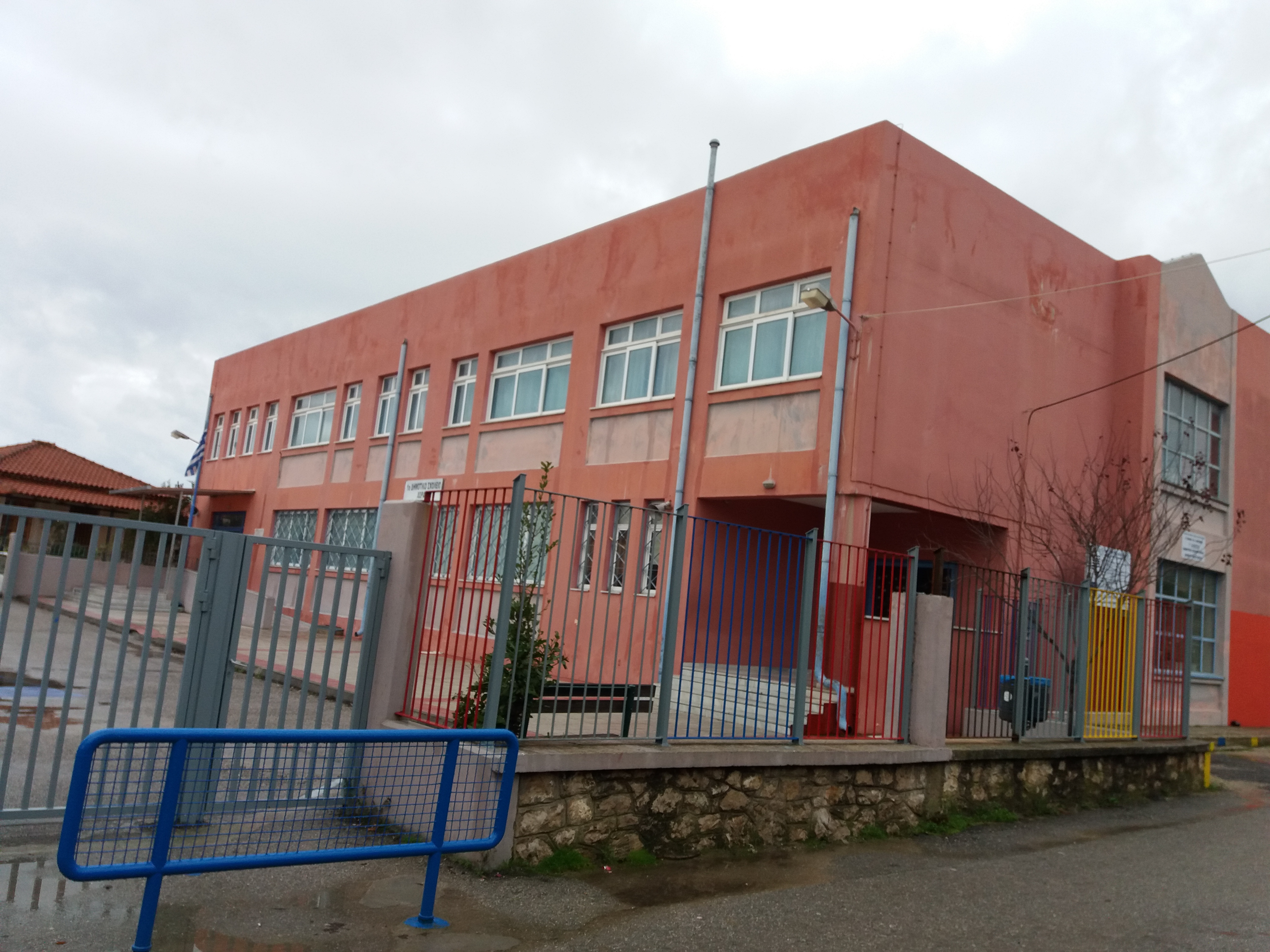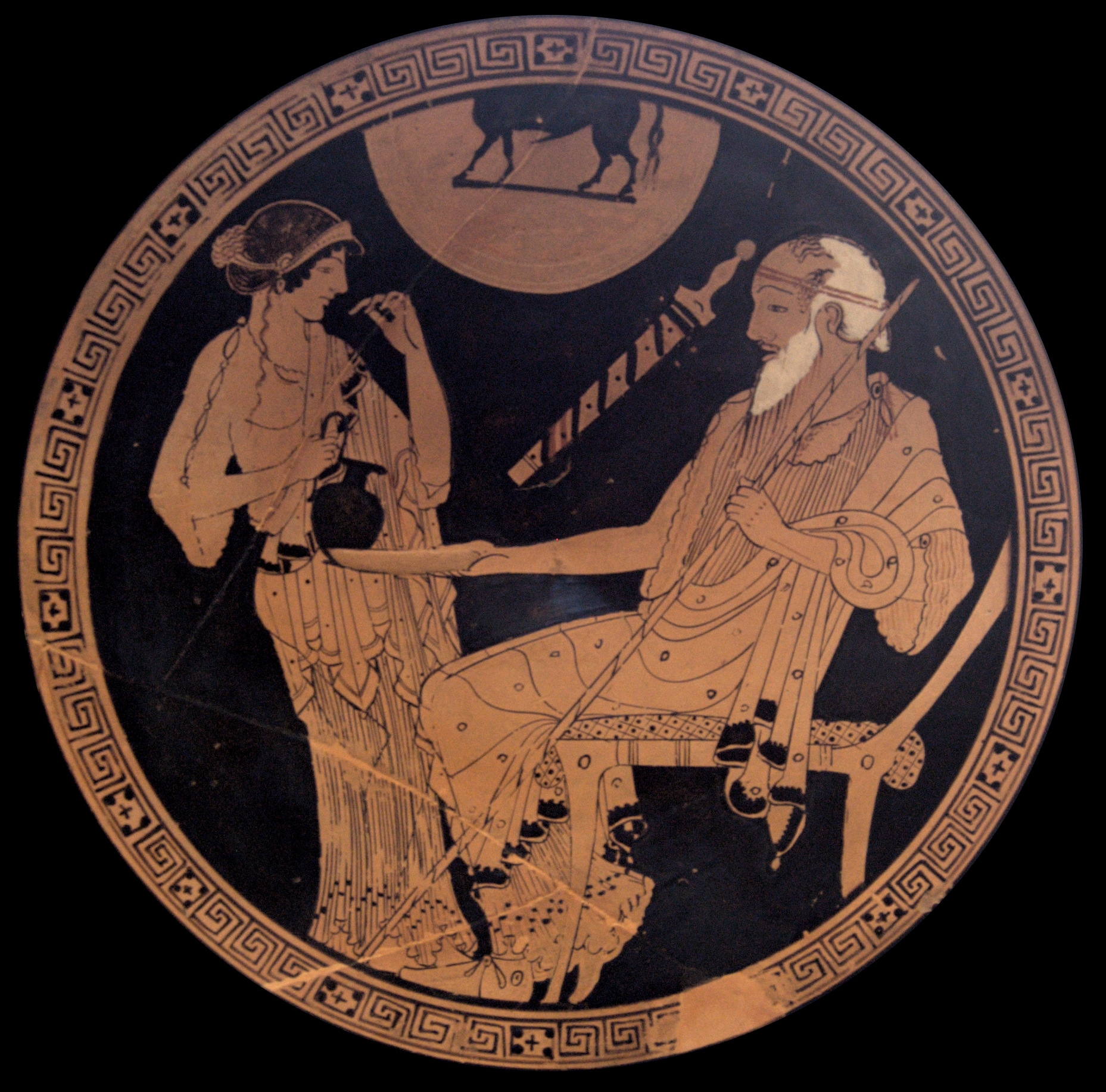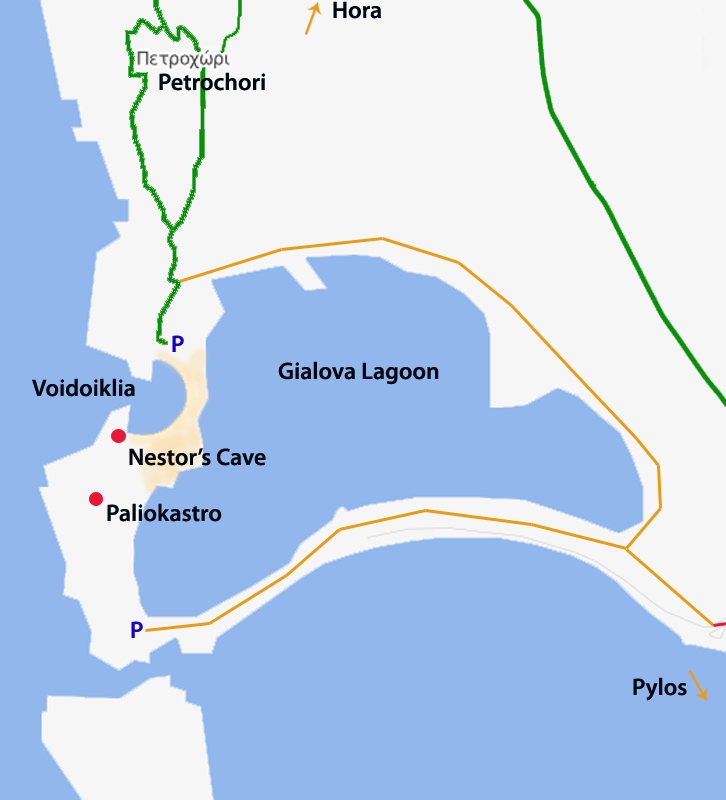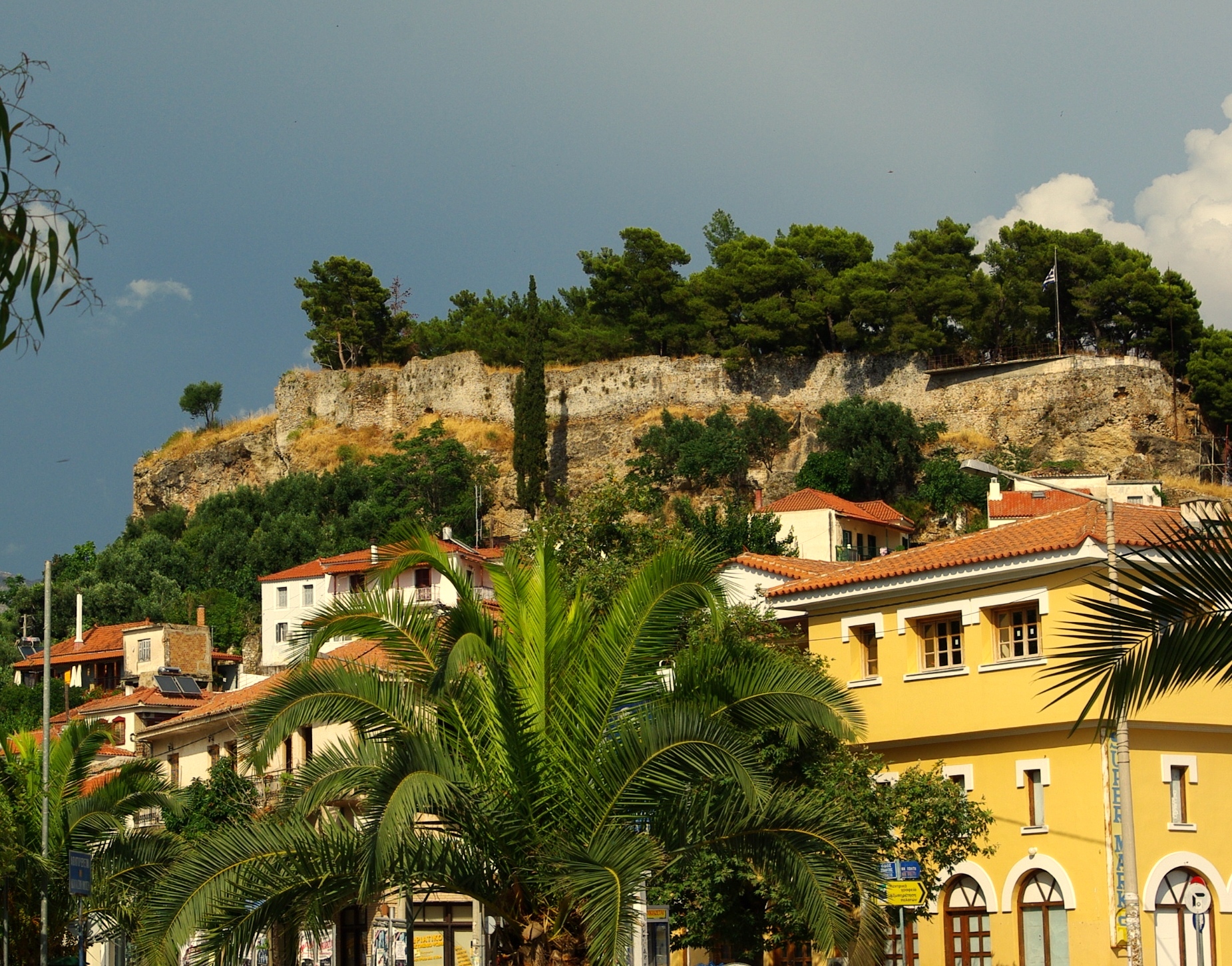|
Chora, Messenia
Chora is a small town in the western part of Messenia, in the Peloponnese region of southern Greece. With a population of 2,609 inhabitants as of 2021, it is the largest settlement in the municipality of Pylos-Nestoras and the sixth largest settlement in Messenia. Chora is renowned for its long history. It houses an archeological museum and it is located 3 kilometers away from the Palace of Nestor. Location Chora is located in the southwestern part of Greece, in the peripheral unit of Messinia in Greece. It is 273 kilometers away from Athens, 205 kilometers away from Patras and 55 kilometers away from Kalamata. It has an altitude of 294 meters and it is built on the foothills of Aigaleo Mountain and 12 kilometers away from the Ionian Sea. Chora is 10 kilometers away from Gargalianoi and 21 kilometers away from Pylos. Romanos beach, Divari beach and the world-famous Voidokilia beach are located near the town. History Chora is associated with Ancient Pylos, one of the most impo ... [...More Info...] [...Related Items...] OR: [Wikipedia] [Google] [Baidu] |
Peloponnese (region)
The Peloponnese Region (, ) is a region in southern Greece. It borders Western Greece to the north and Attica to the north-east. The region has an area of about . It covers most of the Peloponnese peninsula, except for the northwestern subregions of Achaea and Elis which belong to Western Greece and a small portion of the Argolid peninsula that is part of Attica. Administration The Peloponnese Region was established in the 1987 administrative reform. With the 2011 Kallikratis plan, its powers and authority were redefined and extended. Along with the Western Greece and Ionian Islands regions, it is supervised by the Decentralized Administration of Peloponnese, Western Greece and the Ionian Islands based at Patras. The region is based at Tripoli and is divided into five regional units (pre-Kallikratis prefectures), * Arcadia, * Argolis, * Corinthia, * Laconia and * Messenia, which are further subdivided into 26 municipalities. The largest city of the ... [...More Info...] [...Related Items...] OR: [Wikipedia] [Google] [Baidu] |
Gargalianoi
Gargalianoi () is a town and a former municipality in Messenia, Peloponnese, Greece. Since the 2011 local government reform it is part of the municipality Trifylia, of which it is a municipal unit. The municipal unit has an area of 122.680 km2. It is situated from the Ionian Sea coast, north of Pylos, south of Kyparissia and west of Kalamata. The Greek National Road 9 (Patras - Pyrgos - Pylos) passes through the town. Subdivisions The municipal unit Gargalianoi is subdivided into the following communities: * Floka *Gargalianoi * Lefki (including Tragana) * Marathopoli * Mouzaki * Pyrgos * Valta Famous inhabitants * Theophrastos Anagnostopoulos, who later anglicized his name to Theodore Agnew, father of United States Vice President Spiro Agnew Spiro Theodore Agnew (; November 9, 1918 – September 17, 1996) was the 39th vice president of the United States, serving from 1969 until his resignation in 1973. He is the second of two vice presidents to resign, ... [...More Info...] [...Related Items...] OR: [Wikipedia] [Google] [Baidu] |
Greek People's Liberation Army
The Greek People's Liberation Army (, ''Ellinikós Laïkós Apeleftherotikós Stratós''; ELAS) was the military arm of the left-wing National Liberation Front (EAM) during the period of the Greek resistance until February 1945, when, following the ''Dekemvriana'' clashes and the Varkiza Agreement, it was disarmed and disbanded. ELAS was the largest and most significant of the military organizations of the Greek resistance. Birth of ELAS After Nazi Germany attacked the Soviet Union with the initiation of Operation Barbarossa (June 22, 1941) — with most of Greece having fallen under Axis occupation since April and the Battle of Crete having ended on June 1 — the Greek Communist Party (KKE) called for national resistance. The KKE, together with minor parties of the Left, formed a political structure called the National Liberation Front. They were joined by other center-left or non-politicized Greek Resistance militants. On February 16, 1942, EAM gave permission to a c ... [...More Info...] [...Related Items...] OR: [Wikipedia] [Google] [Baidu] |
Battle Of Chora - Agorelitsa (1944)
The Battle of Chora - Agorelitsa was fought on July 19, 1944 between Greek Peoples' Liberation Army (ELAS) against the Nazi occupation forces. Broader context After Aris Velouchiotis' descend to Peloponnese (based on commands of the Political Committee of National Liberation), the Greek Resistance became more active in central and southern Peloponnese to the extent that Peloponnese was considered war zone by the Nazis. The battle The National Liberation Front's political organization had informed ELAS that a battalion of the German occupiers would leave Pylos and head towards Gargalianoi - Kyparissia. Based on this information, ELAS forces hid on July 17 between Ampelofyto (Agorelitsa) and Chora Chora may refer to: Places Greece * Chora, old capital of the island of Alonnisos * Chora, village on the island of Folegandros * Chora, Ios, capital of the island of Ios * Chora, Messenia, a small town in Messenia in the Peloponnese * Chora, p ... to ambush the Nazi forces. On ... [...More Info...] [...Related Items...] OR: [Wikipedia] [Google] [Baidu] |
Volimidia
Volimidia () is an archaeological site in Messenia, in the Peloponnese region of Greece. From the end of the Middle Bronze Age (), it was used as a cemetery, and was the site of a Mycenaean settlement from the Late Helladic I period () until the end of Late Helladic III in around 1180 BCE. The Bronze Age cemetery consists of 35 tombs, mostly identified as chamber tombs. It may have been the site known in the Mycenaean period as Sphagianes, which was a religious centre in the territory of the Palace of Nestor at Pylos. The chamber tombs at Volimidia are morphologically unusual, with rounded chambers and domed roofs rather than the more usual square and sloped constructions. It has been suggested that this may have been in imitation of the more monumental tholos tombs, which are unknown at Volimidia but began to be constructed elsewhere in Messenia at around the same time. Burials were generally made in an extended position, with few grave goods except pottery vessels, thou ... [...More Info...] [...Related Items...] OR: [Wikipedia] [Google] [Baidu] |
Carl Blegen
Carl William Blegen (January 27, 1887 – August 24, 1971) was an American archaeologist who worked at the site of Pylos in Greece and Troy in modern-day Turkey. He directed the University of Cincinnati excavations of the mound of Hisarlik, the site of Troy, from 1932 to 1938. Background Blegen was born in Minneapolis, Minnesota, the eldest of six children born to Anna Regine and John H. Blegen, both of whom had emigrated from Lillehammer, Norway. His younger brother was the historian Theodore C. Blegen. His father was a professor at Augsburg College in Minneapolis for more than 30 years and played a major role in the Norwegian Lutheran Church in America. Blegen earned his bachelor's degree from the University of Minnesota in 1904 and started graduate studies at Yale University in 1907. Career In Greece, he was a fellow at the American School of Classical Studies at Athens between 1911 and 1913, during which time he worked on excavations at Locris, Corinth and Korakou (Corin ... [...More Info...] [...Related Items...] OR: [Wikipedia] [Google] [Baidu] |
Nestor (mythology)
In Greek mythology, Nestor of Gerenia (, ''Nestōr Gerēnios'') was a legendary king of Pylos. He is a prominent secondary character in Homer's ''Iliad'' and ''Odyssey'', where he appears as an elderly warrior who frequently offers advice to the other characters. The Mycenaean Greece, Mycenaean-era palace at Pylos is known as the ''Palace of Nestor'', though there is no evidence that he was an actual person. Description In the account of Dares Phrygius, Dares the Phrygian, Nestor was illustrated as "... large, broad and fair. His nose was long and hooked. He was a wise adviser." Family Nestor was the son of King Neleus of Pylos and Chloris of Pylos, Chloris, daughter of King AmphionBibliotheca (Pseudo-Apollodorus), Apollodorus, 1.9.9; Scholia on Homer, ''Odyssey'' 11.281 citing Pherecydes of Athens, Pherecydes of Orchomenus (Boeotia), Orchomenus. Otherwise, Nestor's mother was called Polymede. His wife was either Eurydice of Pylos, Eurydice or Anaxibia; their children inc ... [...More Info...] [...Related Items...] OR: [Wikipedia] [Google] [Baidu] |
The Archeological Museum Chora
''The'' is a grammatical article in English, denoting nouns that are already or about to be mentioned, under discussion, implied or otherwise presumed familiar to listeners, readers, or speakers. It is the definite article in English. ''The'' is the most frequently used word in the English language; studies and analyses of texts have found it to account for seven percent of all printed English-language words. It is derived from gendered articles in Old English which combined in Middle English and now has a single form used with nouns of any gender. The word can be used with both singular and plural nouns, and with a noun that starts with any letter. This is different from many other languages, which have different forms of the definite article for different genders or numbers. Pronunciation In most dialects, "the" is pronounced as (with the voiced dental fricative followed by a schwa) when followed by a consonant sound, and as (homophone of the archaic pronoun ''thee' ... [...More Info...] [...Related Items...] OR: [Wikipedia] [Google] [Baidu] |
Voidokilia Beach
Voidokilia Beach (, ) is a popular beach in Messinia in the Mediterranean area. In the shape of the Greek letter omega (Ω), its sand forms a semicircular strip of dunes. On the land-facing side of the strip of dunes is Gialova Lagoon, an important bird habitat. The beach has been named "A Place of Particular Natural Beauty". It is part of a Natura 2000 protected area. Location A hiking route begins from Voidokoilia. The climb towards Nestor's Cave begins at the south-west end of the beach, while after the cave the route continues towards Paliokastro. Voidokilia is next to Romanos, Messenia, Petrohori in Messinia, Greece. Though the ruins are not fenced off, the castle ruins are sign-posted as closed and tourists walk through the castle or around the walls at their own risk. Gialova's aquatic habitat, being an important stop for a variety of migratory birds, has been declared the southernmost Habitat of National Importance in the Balkans. It is considered a protected area hosting ... [...More Info...] [...Related Items...] OR: [Wikipedia] [Google] [Baidu] |
Pylos
Pylos (, ; ), historically also known as Navarino, is a town and a former Communities and Municipalities of Greece, municipality in Messenia, Peloponnese (region), Peloponnese, Greece. Since the 2011 local government reform, it has been part of the municipality Pylos-Nestoras, of which it is the seat and a municipal unit. It was the capital of the former Pylia Province. It is the main harbour on the Bay of Navarino. Nearby villages include Gialova, Pyla, Elaiofyto, Schinolakka, and Palaionero. The town of Pylos has 2,568 inhabitants, the municipal unit of Pylos 4,559 (2021). The municipal unit has an area of 143.911 km2. Pylos has been inhabited since Neolithic times. It was a significant kingdom in Mycenaean Greece, with the remains of the so-called "Palace of Nestor" excavated nearby, named after Nestor (mythology), Nestor, the king of Pylos in Homer's ''Iliad''. In Classical Greece, Classical times, the site was uninhabited, but became the site of the Battle of Pylos in 4 ... [...More Info...] [...Related Items...] OR: [Wikipedia] [Google] [Baidu] |
Messinia
Messenia or Messinia ( ; ) is a regional units of Greece, regional unit (''perifereiaki enotita'') in the southwestern part of the Peloponnese (region), Peloponnese Administrative regions of Greece, region, in Greece. Until the implementation of the Kallikratis plan on 1 January 2011, Messenia was a prefectures of Greece, prefecture (''nomos'') covering the same territory. The capital and largest city of Messenia is Kalamata. Geography Physical Messenia borders on Elis (regional unit), Elis to the north, Arcadia (regional unit), Arcadia to the northeast, and Laconia to the southeast. The Ionian Sea lies to the west, and the Gulf of Messinia to the south. The most important mountain ranges are the Taygetus in the east, the Kyparissia mountains in the northwest and the Lykodimo in the southwest. The main rivers are the Neda (river), Neda in the north and the Pamisos (river), Pamisos in central Messenia. Off the south coast of the southwesternmost point of Messenia lie the Mes ... [...More Info...] [...Related Items...] OR: [Wikipedia] [Google] [Baidu] |
Messenia
Messenia or Messinia ( ; ) is a regional unit (''perifereiaki enotita'') in the southwestern part of the Peloponnese region, in Greece. Until the implementation of the Kallikratis plan on 1 January 2011, Messenia was a prefecture (''nomos'') covering the same territory. The capital and largest city of Messenia is Kalamata. Geography Physical Messenia borders on Elis to the north, Arcadia to the northeast, and Laconia to the southeast. The Ionian Sea lies to the west, and the Gulf of Messinia to the south. The most important mountain ranges are the Taygetus in the east, the Kyparissia mountains in the northwest and the Lykodimo in the southwest. The main rivers are the Neda in the north and the Pamisos in central Messenia. Off the south coast of the southwesternmost point of Messenia lie the Messinian Oinousses islands. The largest of these are Sapientza, Schiza and Venetiko. The small island Sphacteria closes off the bay of Pylos. All these islands are virtua ... [...More Info...] [...Related Items...] OR: [Wikipedia] [Google] [Baidu] |






